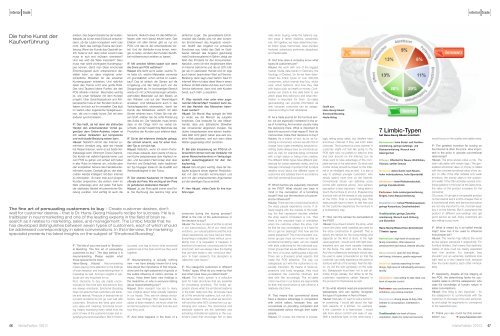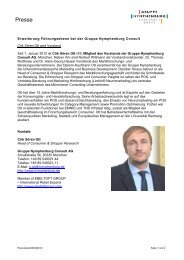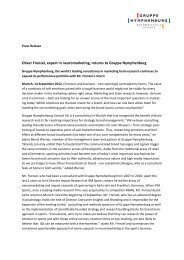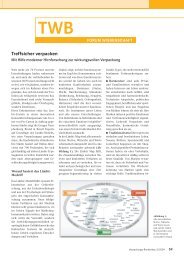als pdf Datei - Gruppe Nymphenburg
als pdf Datei - Gruppe Nymphenburg
als pdf Datei - Gruppe Nymphenburg
You also want an ePaper? Increase the reach of your titles
YUMPU automatically turns print PDFs into web optimized ePapers that Google loves.
[ interior trade ]<br />
Die hohe Kunst der<br />
Kaufverführung<br />
46 InteriorFashion 1|2013<br />
erleben. Das beginnt bereits bei der Außenfassade,<br />
da ist der erste Eindruck entscheidend,<br />
ob der Laden kompetent wirkt oder<br />
nicht. Dann das wichtige Thema der Orientierung:<br />
Wenn der Kunde das Geschäft betritt,<br />
findet er sich dann sofort zurecht oder<br />
muss er sich erst mühsam orientieren?<br />
Und wie wird die Ware inszeniert? Dazu<br />
muss man seine wichtigsten Kundengruppen<br />
kennen, damit man diese emotionale<br />
Einrichtungswelt auch entsprechend darstellen<br />
kann, so dass möglichst unterschiedliche<br />
Stilwelten für die einzelnen<br />
Kundengruppen entstehen. Und natürlich<br />
spielt das Thema Licht eine große Rolle.<br />
Das sind Tausend kleine Punkte, die den<br />
POS attraktiv machen. Besonders wichtig<br />
ist, wie unser Verkäufer mit dem Kunden<br />
umgeht. Über Gesichtsausdruck und Körpersprache<br />
muss er den Kunden intuitiv erfassen<br />
und sich auf ihn einstellen. Das läuft<br />
im Gehirn über sogenannte Spiegelneuronen,<br />
die uns in relativ kurzer Zeit mit dem<br />
anderen synchronisieren.<br />
IF: Das heißt, da hat dann der stationäre<br />
Handel den entscheidenden Vorteil gegenüber<br />
dem Online-Anbieter, indem er<br />
mit seinen Verkäufern auf kompetente<br />
und individuelle Beratung setzen kann.<br />
Häusel: Natürlich nimmt das Internet zunehmend<br />
Umsätze weg, aber der Handel<br />
hat Riesenchancen, wenn er auf beide Vertriebswege<br />
setzt. Stichwort Cross Channel.<br />
Der Kunde hat vielleicht gerade keine Lust<br />
zum POS zu gehen und schaut sich lieber<br />
in aller Ruhe im Internet um, möchte aber<br />
den kompletten Service des Handelsunternehmens<br />
nutzen. Deshalb gilt es, den stationären<br />
Handel intelligent mit dem Internet<br />
zu verknüpfen. So kann man auch jüngere<br />
Kunden ansprechen, die einfach mehr im<br />
Netz unterwegs sind. Auf jeden Fall kann<br />
der stationäre Handel mit persönlicher Beratung<br />
punkten. Und wichtig ist auch die<br />
IF: The title of your new book is “Emotional<br />
Boosting. The fine art of persuading<br />
customers to buy”. The idea behind it is<br />
neuromarketing. Please explain what<br />
those special terms mean.<br />
Hans-Georg Häusel: Neuromarketing<br />
means paying more attention to the findings<br />
of brain research and implementing them in<br />
marketing as well. And two insights in particular<br />
are very important for us:<br />
First, decisions to buy are made unconsciously<br />
for the most part, and second, they<br />
are always emotional. Emotional Boosting<br />
does not assume that customers are sensible<br />
and rational. Products or brands that do<br />
not elicit emotions do not go over well with<br />
customers. Emotions are what give products<br />
value and meaning. Emotional boosting<br />
means examining every detail from the<br />
point of view of the customer’s brain and intensifying<br />
its emotional effect. But for that to<br />
Sensorik, dadurch dass ich das Möbel anfassen<br />
oder mich darauf setzen kann. Das<br />
Erleben mit allen Sinnen gibt es nur am<br />
POS, und das ist der entscheidende Vorteil.<br />
Und der Verkäufer muss lernen, weniger<br />
zu reden, sondern den Kunden die Möbel<br />
multisensorisch erleben zu lassen.<br />
IF: Mit welchen Mitteln lassen sich denn<br />
die Sinne am POS verführen?<br />
Häusel: Wie riecht es im Laden, welche Töne<br />
habe ich, welche Materialien verwende<br />
ich grundsätzlich schon einmal im Ladenbau?<br />
Das ist einfach der Sensor auf die<br />
Umgebung und das hängt auch von der<br />
Shoppingwelt ab. Im hochwertigen Bereich<br />
würde ich mit Lichtinszenierungen arbeiten,<br />
wertvollere Materialien auf den Böden, an<br />
den Wänden und auf den Warenträgern<br />
einsetzen. Und Multisensorik auch in das<br />
Verkaufsgespräch einbeziehen, damit der<br />
Kunde das Möbelstück wirklich mit allen<br />
Sinnen erfahren kann: Fühlen Sie mal diesen<br />
Stoff, erleben Sie die softe Polsterung<br />
des Sofas etc. Der Verkäufer muss lernen,<br />
dass er die Dinge nicht nur verbal beschreibt,<br />
sondern bestimmte Merkmale des<br />
Produktes den Kunden auch erfahren lässt.<br />
IF: Da ist der erfahrene Verkäufer gefragt,<br />
der schnell erkennt, was für einen Kunden-Typ<br />
er vor sich hat.<br />
Häusel: Natürlich, wenn ich einem Performer<br />
etwas verkaufe, dann werde ich bei einer<br />
Küche beispielsweise über Hightech reden,<br />
und bei einem Harmoniser eher über<br />
Komfort und Einfachheit, beim traditionellen<br />
Typ hingegen stelle ich die Qualität und<br />
Wertbeständigkeit in den Fokus.<br />
IF: Der oberste Kaufanreiz im Internet ist<br />
oftm<strong>als</strong> der Preis. Wie wichtig ist der Preis<br />
im gehobenen stationären Handel?<br />
Häusel: Ja, der Preis spielt immer eine Rolle.<br />
Die Rechnung des Gehirns folgt einer<br />
The fine art of persuading customers to buy – Create customer desires, don’t<br />
wait for customer desires – that is Dr. Hans-Georg Häusel’s recipe for success. He is a<br />
trailblazer in neuromarketing and one of the leading experts in the field of brain research<br />
as it relates to marketing, sales, and management. The Limbic Model that he<br />
has developed distinguishes between seven types of customers, each of which should<br />
be addressed correspondingly in sales conversations. In this interview, the marketing<br />
specialist presents his latest insights on the subject of “Emotional Boosting”.<br />
succeed, one has to know what emotional<br />
systems are in the brain and how they work<br />
together.<br />
IF: Neuromarketing is actually nothing<br />
new – we have already known for a long<br />
time about the importance of first impressions<br />
and the right placement of goods or<br />
the subtle influence of colors, aromas, or<br />
music. Have there been new findings in<br />
the meantime, or why is everyone talking<br />
about neuromarketing now?<br />
Häusel: Brain research has led to many<br />
new insights about what actually happens<br />
in our heads. They are not always revolutionary<br />
new findings. But meanwhile, because<br />
of brain research, we know what the<br />
emotional systems in the brain look like and<br />
how they work.<br />
IF: And what happens in the brain of a<br />
einfachen Logik: Der generalisierte Emotionswert<br />
des Geldes wird mit dem konkreten<br />
Emotionswert des Angebots verrechnet.<br />
Strahlt das Angebot nur schwache<br />
Emotionen aus, bleibt das Geld im Geldbeutel.<br />
Aktiviert das Angebot gleichzeitig<br />
viele Emotionssysteme im Gehirn, steigt der<br />
Wert des Produkts für den Konsumenten.<br />
Natürlich, wenn ich eine vergleichbare Ware<br />
im Internet bekomme und die ist 20% billiger<br />
<strong>als</strong> im stationären Handel und ich lege<br />
auch keinen besonderen Wert auf Service-<br />
Beratung, dann sagt unser Gehirn: Kauf im<br />
Internet! Wenn ich aber diese Ware in einem<br />
anderen Umfeld erlebe und dazu auch noch<br />
Service bekomme, dann sind viele Kunden<br />
bereit, auch mehr zu bezahlen.<br />
IF: Was versteht man unter einer sogenannten<br />
Mental Map? Inwiefern kann damit<br />
das Handeln des Menschen beeinflusst<br />
werden?<br />
Häusel: Die Mental Map spiegelt die Welt<br />
so wider, wie der Mensch sie subjektiv<br />
empfindet. Das bedeutet für den Möbelhandel,<br />
dass sich ästhetische Stilwelten<br />
klar voneinander abgrenzen müssen. Sie<br />
dürfen beispielsweise eine extrem traditionelle<br />
Welt nicht gleich neben eine sehr kreative<br />
Welt platzieren, weil sich dann diese<br />
Welten gegenseitig sofort zerstören.<br />
IF: Bei aller Inszenierung am POS ist offensichtlich<br />
immer noch der Verkäufer mit<br />
seiner Menschenkenntnis im Verkaufsgespräch<br />
ausschlaggebend für den Verkaufserfolg.<br />
Häusel: Eins ist ganz wichtig, dass der Verkäufer<br />
aufgrund seiner eigenen Persönlichkeit<br />
mit dem Kunden kommuniziert und<br />
sich mit den entsprechenden Argumenten<br />
auf den jeweiligen Typus einstellt.<br />
IF: Herr Häusel, vielen Dank für Ihre Ausführungen.<br />
consumer during the buying process?<br />
What is the role of the subconscious in<br />
the decision to buy?<br />
Häusel: We have no idea of all that is stored<br />
in our subconscious. All of our views and<br />
emotions, our cultural patterns and the individual<br />
experiences we have had are there.<br />
Everything is evaluated there without us realizing<br />
how it is evaluated. It happens in<br />
fractions of a second, unconsciously for the<br />
most part, and we always have the feeling<br />
that we have made a very conscious decision.<br />
In brain research, this deception is<br />
called the “user illusion”.<br />
IF: You categorize customers in different<br />
“limbic” types. What do you mean by that<br />
and what types have you determined?<br />
Häusel: The limbic system is a collective<br />
term for brain structures that are essential<br />
for processing emotions. The limbic approach<br />
shows what the emotional systems<br />
in the brain really look like. All people have<br />
all of the emotional systems, but not all to<br />
the same extent. 50% is what we are born<br />
with and the other 50% comes from our upbringing<br />
and culture. The dominance and<br />
stimulant systems are the optimistic and<br />
activating motivational systems in the customer’s<br />
head that encourage him to take<br />
risks when buying, while the balance system<br />
plays a rather inhibitive, pessimistic<br />
role. All together, we have determined seven<br />
limbic types: harmonizer, open-minded,<br />
hedonist, adventurer, performer, disciplined,<br />
and traditionalist.<br />
IF: And how does a company know what<br />
types its customers are?<br />
Häusel: We work with one of the biggest<br />
market media data banks in Germany, the<br />
Typology of Desires. So far we have determined<br />
the limbic types of over 200,000<br />
consumers, which brands they buy, which<br />
cars, which fashions, and how they deal<br />
with topics such as health or money. Companies<br />
can check in this data bank to see<br />
which areas they belong to and what information<br />
is important for them. So-called<br />
geomarketing can provide information as<br />
well, because customers can be categorized<br />
according to their addresses.<br />
IF: As a trade journal for the furniture sector,<br />
we are especially interested in the area<br />
of furnishing. And women usually make<br />
the decisions there. What is important to<br />
take into account in that respect? How do<br />
men/women make their decisions to buy?<br />
Häusel: As a matter of fact, as far as furnishing<br />
is concerned, women are still 70% in<br />
charge. Now it gets interesting, because furnishing<br />
styles always have an emotional aspect<br />
as well, for example being connected<br />
with a high status or being more creative.<br />
The different limbic types have different preferences<br />
for certain aesthetic styles, and it is<br />
naturally immensely important that furniture<br />
retailers know about the different types of<br />
customers and address them in accordance<br />
with their emotional focal points.<br />
IF: Which factors are especially important<br />
at the POS? What should one bear in<br />
mind in the conception of a furnishing<br />
house? How can the emotions of customers<br />
be influenced?<br />
Häusel: There are lots of individual facets in<br />
the ways people experience rooms. It already<br />
begins with the outside of the building;<br />
the first impression decides whether<br />
the shop seems competent or not. Then<br />
there is the important topic of orientation<br />
when the customer enters the store. Can<br />
he find his way immediately or is it hard for<br />
him to get his bearings? And how are the<br />
wares presented? The most important customer<br />
groups must be known so that an<br />
emotional furnishing realm can be created<br />
with style collections for the individual customer<br />
groups that are as different as possible.<br />
And, of course, lighting plays a big role.<br />
There are a thousand small aspects that<br />
make the POS attractive. The way our<br />
salespeople act with the customers is especially<br />
important. By means of facial expressions<br />
and body language, they must<br />
understand the customer intuitively and<br />
deal with him accordingly. The so-called<br />
mirror neurons in our brains are responsible<br />
for that; they synchronize us with others in a<br />
relatively short time.<br />
IF: That means that conventional stores<br />
have a decisive advantage in comparison<br />
with online sellers, because they can<br />
concentrate on providing competent and<br />
individualized advice through their salespeople.<br />
Häusel: Of course, the Internet is increas-<br />
Grafik aus:<br />
Hans-Georg Häusel:<br />
Emotional Boosting,<br />
Haufe-Verlag<br />
ingly taking away sales, but retailers have<br />
enormous chances if they use both sales<br />
channels. The buzzword is cross channel. A<br />
customer might not feel like going to the<br />
POS right now, he prefers to take his time<br />
and look around on the Internet, but he<br />
does want to take advantage of the complete<br />
service of the retail store. So brick and<br />
mortar stores should be linked to the Internet<br />
in an intelligent way as well. It is <strong>als</strong>o a<br />
way to address younger customers, who<br />
simply spend more time on the Internet.<br />
Conventional stores can definitely score<br />
points with personal advice. And sensory<br />
perception is <strong>als</strong>o important – being able to<br />
touch the furniture or sit on it. Experiencing<br />
furniture with all the senses is only possible<br />
at the POS. That is something else that<br />
sales people have to learn: to talk less and<br />
let the customer experience the furniture in<br />
a multisensory way.<br />
IF: How can the senses be persuaded at<br />
the POS?<br />
Häusel: How does it smell in the shop, what<br />
colors are used, what materi<strong>als</strong> are used for<br />
the store construction in general? That is<br />
simply the sensor for the surroundings and<br />
depends on the kind of store. In the high<br />
value segment, I would work with light presentations<br />
and use more valuable materi<strong>als</strong><br />
for the floors, the walls and the displays.<br />
And the multisensory technique should <strong>als</strong>o<br />
be used in sales conversations so that the<br />
customer can really experience the piece of<br />
furniture with all of his senses: Feel this fabric,<br />
try out the soft upholstery on the sofa,<br />
etc. Salespeople must learn not to just describe<br />
things verbally, but rather to let the<br />
customers experience certain features of<br />
the product for themselves as well.<br />
IF: So what retailers need are experienced<br />
salespeople who can quickly recognize<br />
the type of customer in front of them.<br />
Häusel: Naturally, if I want to sell a performer<br />
something, I would talk about the high<br />
tech aspects of a kitchen, for example.<br />
If the customer is a harmonizer, I would<br />
talk more about comfort and ease of use.<br />
With a traditional type, on the other hand, I<br />
7 Limbic-Typen<br />
hat Hans-Georg Häusel ermittelt:<br />
Harmoniser: hohe Sozial- und Familienorientierung,<br />
geringe Aufstiegs- und<br />
Statusorientierung, Wunsch nach<br />
Geborgenheit<br />
Offener: Offenheit für Neues, Wohlfühlen,<br />
Toleranz, sanfter Genuss<br />
Hedonist: aktive Suche nach Neuem,<br />
hoher Individualismus, hohe Spontanität<br />
Abenteurer: hohe Risikobereitschaft,<br />
geringe Impulskontrolle<br />
Performer: hohe Leistungsorientierung,<br />
Ehrgeiz, hohe Statusorientierung<br />
Disziplinierter: hohes Pflichtbewusstsein,<br />
geringe Konsumlust, Detailverliebtheit<br />
Traditionalist: geringe Zukunftsorientierung,<br />
Wunsch nach Ordnung<br />
und Sicherheit<br />
Hans-Georg Häusel has determined<br />
7 limbic types:<br />
Harmonizer: high level of social and<br />
family orientation, little interest in<br />
advancement and status, desires security<br />
Open-minded: open for new things,<br />
well-being, tolerance, gentle enjoyment<br />
Hedonist: actively searching for new<br />
things, high level of individuality and spontaneity<br />
Adventurer: very willing to take risks, low<br />
level of impulse control<br />
Performer: very performance-oriented,<br />
ambitious, very status-oriented<br />
Disciplined: strong sense of duty, little<br />
interest in consumption, interested in<br />
details<br />
Traditionalist: low level of future<br />
orientation, desire for order and security<br />
[ interior trade ]<br />
would focus on the quality and stable value.<br />
IF: The greatest incentive for buying on<br />
the Internet is often the price. How important<br />
is the price in upscale conventional<br />
retail stores?<br />
Häusel: The price always plays a role. The<br />
brain calculates with simple logic: The generalized<br />
emotional value of money is tallied<br />
with the concrete emotional value of the object<br />
on offer. If the offer radiates only weak<br />
emotions, the money stays in the customer’s<br />
wallet. If the offer activates several emotional<br />
systems in the brain at the same time,<br />
the value of the product increases for the<br />
consumer.<br />
Of course, if I can get a comparable product<br />
on the Internet and it is 20% cheaper than in<br />
a conventional store, and service and advice<br />
are not very important to me, my brain says:<br />
buy it on the Internet. But if I experience the<br />
product in different surroundings and get<br />
good service as well, many customers are<br />
<strong>als</strong>o willing to pay more.<br />
IF: What is meant by a so-called mental<br />
map? How can it be used to influence<br />
how people act?<br />
Häusel: The mental map reflects the world<br />
as the person perceives it subjectively. For<br />
furniture retailers, that means that aesthetic<br />
realms of style must be clearly separated<br />
from one another. For example, they<br />
shouldn’t put an extremely traditional look<br />
right next to a very creative look, because<br />
then the looks destroy each other immediately.<br />
IF: Apparently, despite all the staging at<br />
the POS, the determining factor for successful<br />
sales is still the salesperson who<br />
uses his knowledge of human nature in<br />
sales conversations.<br />
Häusel: One thing is very important – for<br />
the salesperson to communicate with the<br />
customer on the basis of his own personality<br />
and adapt his arguments to correspond<br />
to the respective type.<br />
IF: Thank you very much for this conversation!<br />
hoe ➜ www.haeusel.com<br />
InteriorFashion 1|2013<br />
47








